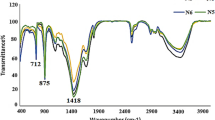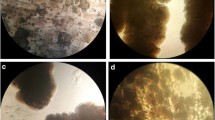Abstract
Urease-producing bacteria are abundant in soils, which can precipitate calcium carbonate nanocrystals by enzymatic hydrolysis of urea in the presence of calcium ions. This process is known as microbially induced calcium carbonate precipitation (MICP), and it has received much attention in recent years as an eco-friendly technology. Therefore, the purpose of the present study was to isolate local extremophile bacterial strains capable of producing calcium carbonate. Among a total of 44 isolated urease-producing strains from sandy soils, one strain with a high level of urease activity (8.16 U/ml) and production of a large amount of calcium carbonate (410 mg/100 ml) was selected for further investigation. 16S rRNA gene sequencing showed that this strain had 99.66% sequence identity to Bhargavaea cecembensis. The SEM-EDX and XRD analyses indicated that irregular vaterite and aggregated nanocalcite were the dominant polymorphs produced by this strain. The size of these nanocalcite crystals ranged between 25 and 42 nm. The selected strain showed high levels of tolerance to different conditions of temperature, pH, and salinity. This strain grows at high temperatures up to 50 °C, alkaline pH (9–11), and high concentrations of NaCl (20–25% w/v). Flow cytometry analysis demonstrated 96% cell viability of the isolated strain after desiccation stress. Bhargavaea was first reported in 2009 as a new genus, and it belongs to the Firmicutes. So far, there has been no report on its MICP potential. The present study is the first one to report nanocrystal calcium carbonate precipitation in polyextremophile Bhargavaea cecembensis, which makes it a suitable candidate for bio-cementation under extreme circumstances.
Graphical abstract








Similar content being viewed by others
Data Availability
All data generated during this study are included in this published article.
References
Anbu P, Kang CH, Shin YJ, So JS (2016) Formations of calcium carbonate minerals by bacteria and its multiple applications. Springerplus 5(1):1–26. https://doi.org/10.1186/s40064-016-1869-2
Chen Y, Feng Y, Deveaux JG, Masoud MA, Chandra FS, Chen H et al (2019) Biomineralization forming process and bio-inspired nanomaterials for biomedical application: a review. Minerals 9(2):68. https://doi.org/10.3390/min9020068
Dhami NK, Reddy MS, Mukherjee A (2013) Biomineralization of calcium carbonate polymorphs by the bacterial strains isolated from calcareous sites. J Microbiol Biotechnol 23(5):707–714. https://doi.org/10.4014/jmb.1212.11087
Marjadi DS (2016) Conservation and restoration of cultural heritage: A biotechnological approach. Adv Appl Sci Res 7(4):159–167 www.pelagiaresearchlibrary.com
Boquet E, Boronat A, Ramos-Cormenzana A (1973) Production of calcite (calcium carbonate) crystals by soil bacteria is a general phenomenon. Nature 246(5434):527–529. https://doi.org/10.1038/246527a0
Ghosh T, Bhaduri S, Montemagno C, Kumar A (2019) Sporosarcina pasteurii can form nanoscale calcium carbonate crystals on cell surface. PLoS One 14(1):e0210339. https://doi.org/10.1371/journal.pone.0210339.g006
Chaparro-Acuña SP, Becerra-Jiménez ML, Martínez-Zambrano JJ, Rojas-Sarmiento HA (2018) Soil bacteria that precipitate calcium carbonate: mechanism and applications of the process. Acta Agron 67(2):277–288. https://doi.org/10.15446/acag.v67n2.66109
Omoregie AI, Ong DEL, Nissom PM (2019) Assessing ureolytic bacteria with calcifying abilities isolated from limestone caves for biocalcification. Lett Appl Microbiol 68(2):173–181. https://doi.org/10.1111/lam.13103
Omoregie AI, Palombo EA, Nissom PM (2020) Bioprecipitation of calcium carbonate mediated by ureolysis: a review. Environ Eng Res:4491. https://doi.org/10.4491/eer.2020.379
Gao Y, Tang X, Chu J, He J (2019) Microbially induced calcite precipitation for seepage control in sandy soil. Geomicrobiol J 36(4):366–375. https://doi.org/10.1080/01490451.2018.1556750
Ghezelbash GR, Haddadi M (2018) Production of nanocalcite crystal by a urease producing halophilic strain of Staphylococcus saprophyticus and analysis of its properties by XRD and SEM. World J Microbiol Biotechnol 34(12):1–10. https://doi.org/10.1007/s11274-018-2544-2
Dikshit R, Jain A, Dey A, Kumar A (2020) Microbially induced calcite precipitation using Bacillus velezensis with guar gum. PLoS One 15(8):e0236745. https://doi.org/10.1371/journal.pone.0236745
Helmi FM, Elmitwalli HR, Elnagdy SM, El-Hagrassy AF (2016) Calcium carbonate precipitation induced by ureolytic bacteria Bacillus licheniformis. Ecol Eng 90:367–371. https://doi.org/10.1016/j.ecoleng.2016.01.044
Zhu T, Dittrich M (2016) Carbonate precipitation through microbial activities in natural environment, and their potential in biotechnology: a review. Front Bioeng Biotechnol 4:4. https://doi.org/10.3389/fbioe.2016.00004
Phillips AJ, Gerlach R, Lauchnor E, Mitchell AC, Cunningham AB, Spangler L (2013) Engineered applications of ureolytic biomineralization: a review. Biofouling 29(6):715–733. https://doi.org/10.1080/08927014.2013.796550
Haouzi FZ, Courcelles B (2018) Major applications of MICP sand treatment at multi-scale levels: a review. in Conf. Proceed. GeoEdmonton. GeoEdmonton2018Paper_VFinal.pdf
Ortega-Villamagua E, Gudiño-Gomezjurado M, Palma-Cando A (2020) Microbiologically induced carbonate precipitation in the restoration and conservation of cultural heritage materials. Molecules 25(23):5499. https://doi.org/10.3390/molecules25235499
Mohanasundharam C, Jeevakkumar R, Shankar K (2014) An experimental study on performance of bacteria in concrete. Int J Innov Res Comput Sci Technol (IJIRCST) 2:5 https://www.ijircst.org/DOC/1_irp207.pdf
Cameotra SS (2016) Calcifying bacteria: their applications. J Petrol Environ Biotechnol 7(3):1. https://doi.org/10.4172/2157-7463.1000e127
Misiołek K, Popielski P, Affek K (2018) Preliminary research for identification of bacteria useful in microbially induced calcium carbonate precipitation. in E3S Web of Conferences 44:00115. https://doi.org/10.1051/e3sconf/20184400115
Wei S, Hongpeng C, Zhenglong J, Hao L, Hao H, Nianqiao F (2015) Biomineralization processes of calcite induced by bacteria isolated from marine sediments. Braz J Microbiol 46(2):455–464. https://doi.org/10.1590/S1517-838246220140533
Zhu Y, Ma N, Jin W, Wu S, Sun C (2017) Genomic and transcriptomic insights into calcium carbonate biomineralization by marine actinobacterium Brevibacterium linens BS258. Front Microbiol 8:602. https://doi.org/10.3389/fmicb.2017.00602
Hammad IA, Talkhan F, Zoheir A (2013) Urease activity and induction of calcium carbonate precipitation by Sporosarcina pasteurii NCIMB 8841. J Appl Sci Res 9(3):1525–1533
Rajasekar A, Wilkinson S, Sekar R, Bridge J, Medina-Roldan E, Moy CK (2018) Biomineralisation performance of bacteria isolated from a landfill in China. Can J Microbiol 64(12):945–953. https://doi.org/10.1139/cjm-2018-0254
Mao DP, Zhou Q, Chen CY, Quan ZX (2012) Coverage evaluation of universal bacterial primers using the metagenomic datasets. BMC Microbiol 12(1):1–8. https://doi.org/10.1186/1471-2180-12-66
Alegría Á, Álvarez-Martín P, Sacristán N, Fernández E, Delgado S, Mayo B (2009) Diversity and evolution of the microbial populations during manufacture and ripening of Casín, a traditional Spanish, starter-free cheese made from cow’s milk. Int J Food Microbiol 136(1):44–51. https://doi.org/10.1016/j.ijfoodmicro.2009.09.023
Pavlopoulos GA, Soldatos TG, Barbosa-Silva A, Schneider R (2010) A reference guide for tree analysis and visualization. BioData Mini 3(1):1–24. https://doi.org/10.1186/1756-0381-3-1
Okyay TO, Rodrigues DF (2013) High throughput colorimetric assay for rapid urease activity quantification. J Microbiol Methods 95(3):324–326. https://doi.org/10.1016/j.mimet.2013.09.018
Kim HJ, Eom HJ, Park C, Jung J, Shin B, Kim W et al (2016) Calcium carbonate precipitation by Bacillus and Sporosarcina strains isolated from concrete and analysis of the bacterial community of concrete. J Microbiol Biotechnol 26(3):540–548. https://doi.org/10.4014/jmb.1511.11008
Akond MA, Jahan MN, Sultana N, Rahman F (2016) Effect of temperature, pH and NaCl on the isolates of Actinomycetes from straw and compost samples from Savar, Dhaka, Bangladesh. Am J Microbiol Immunol 1(2):10–15 https://creativecommons.org/licenses/by/4.0/
Etemadifar Z, Gholami M, Derikvand P (2016) UV-resistant bacteria with multiple-stress tolerance isolated from desert areas in Iran. Geomicrobiol J 33(7):1–7. https://doi.org/10.1080/01490451.2015.1063025
Terzis D, Laloui L (2019) A decade of progress and turning points in the understanding of bio-improved soils: a review. Geomech Energy Environ 19:100116. https://doi.org/10.1016/j.gete.2019.03.001
Zhao Y, Ge F, Yang Y (2019) Factors affecting bio-cemented typical silt from .middle and lower reaches of Yellow River. in IOP Conference Series: Earth and Environmental Science 304:022061. https://doi.org/10.1088/1755-1315/304/2/022061
Manorama R, Pindi P, Reddy G, Shivaji S (2009) Bhargavaea cecembensis gen. nov., sp. nov., isolated from the Chagos–Laccadive ridge system in the Indian Ocean. Int J Syst Evol Microbiol 59(10):2618–2623. https://doi.org/10.1099/ijs.0.002691-0
Omoregie AI (2016) Characterization of ureolytic bacteria isolated from limestone caves of sarawak and evaluation of their efficiency in biocementation. Swinburne University of Technology (Sarawak Campus), Malaysia. https://doi.org/10.13140/RG.2.2.11719.55205
Enyedi NT, Makk J, Kótai L, Berényi B, Klébert S, Sebestyén Z et al (2020) Cave bacteria-induced amorphous calcium carbonate formation. Sci Rep 10(1):1–12. https://doi.org/10.1038/s41598-020-65667-w
Costa L, Olyveira G, Salomão R (2017) Precipitated calcium carbonate nano-microparticles: applications in drug delivery. Adv Tissue Eng Regen Med Open Access 3(2):00059. https://doi.org/10.15406/atroa.2017.03.00059
Uad I, Gonzalez LJ, Silva CG, Vílchez J, Gonzalez MA, Martin RD et al (2014) Precipitation of Carbonates Crystals by Bacteria Isolated from a Submerged fixed-film Bioreactor used for the Treatment of urban Wastewater. Int J Environ Res 8(2):435–446. https://doi.org/10.22059/IJER.2014.73
Merino N, Aronson HS, Bojanova DP, Feyhl-Buska J, Wong ML, Zhang S, Giovanneli D (2019) Living at the extremes: extremophiles and the limits of life in a planetary context. Front Microbiol 10:780. https://doi.org/10.3389/fmicb.2019.00780
Belov AA, Chesstov VS, Vorobyova EA (2018) Soil bacteria communities of Sahara and Gibson deserts: physiological and taxonomical characteristics. AIMS Microbiol 4(4):685–710. https://doi.org/10.3934/microbiol.2018.4.685
Adrio JL, Demain AL (2014) Microbial enzymes: tools for biotechnological processes. Biomolecules 4(1):117–139. https://doi.org/10.3390/biom4010117
Acknowledgements
We are most thankful to the University of Isfahan and its financial support for this work.
Funding
This study was supported by a grant from the University of Isfahan, Iran.
Author information
Authors and Affiliations
Contributions
F.E. conducted the experiments, carried out data analysis, and wrote the first draft. Z.E. and G.E. designed and supervised the research. Z.E. also reviewed the manuscript and assisted with data analysis. All authors read and approved the final manuscript.
Corresponding author
Ethics declarations
Consent to Participate
Not applicable.
Consent for Publication
Not applicable
Competing Interests
The authors declare no competing interests.
Rights and permissions
About this article
Cite this article
Elmi, F., Etemadifar, Z. & Emtiazi, G. Biosynthesis of Calcite Nanocrystal by a Novel Polyextremophile Bhargavaea cecembensis-Related Strain Isolated from Sandy Soil. Microb Ecol 85, 698–707 (2023). https://doi.org/10.1007/s00248-022-01977-y
Received:
Accepted:
Published:
Issue Date:
DOI: https://doi.org/10.1007/s00248-022-01977-y







